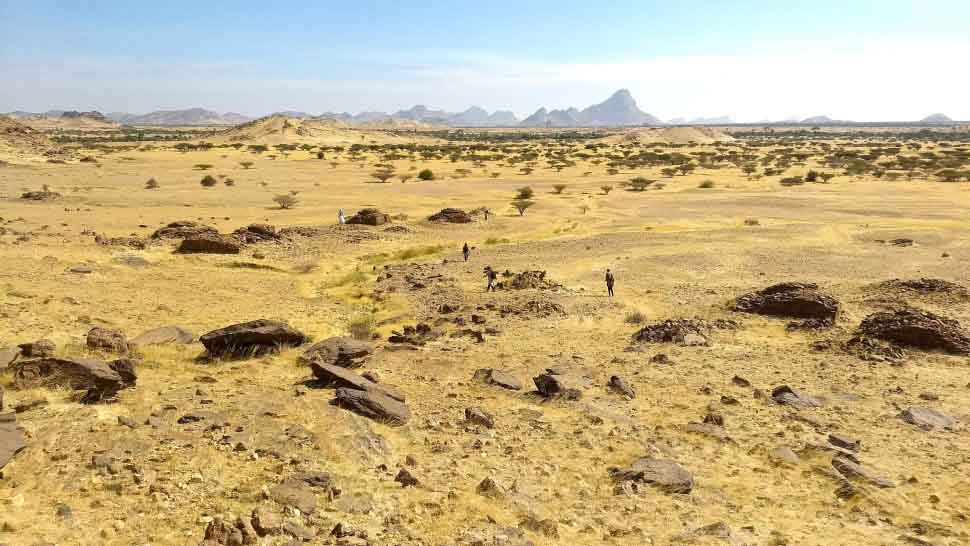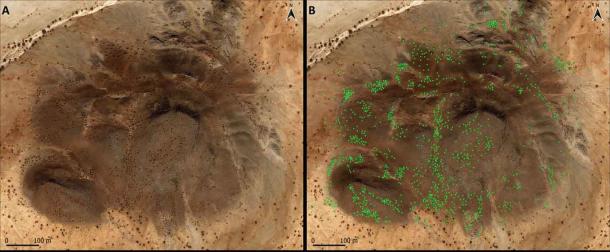
UPDATED 9 JULY, 2021 - 14:57 ASHLEY COWIE
Sudanese Islamic burial sites are not randomly located as was traditionally believed. Quite the opposite. Thanks to satellite technology , it has been discovered that contrary to the belief that these Islamic burials were scattered randomly across the ancient landscape, thousands of burial sites follow a “galaxy-like” distribution pattern.
Knowing this audience, I know I am safe to open this story with the deeply-gnostic statement: “As above, so below.” I am confident that a vast majority of you will understand the implications associated with that concept, and by the end of this article it will become perfectly clear why I chose this sentence to represent the findings of a new study published in the open-access journal PLOS ONE by Stefano Costanzo of the University of Naples “L’Orientale.”

Islamic burial qubbas scattered around the Jebel Maman in Sudan. (Costanzo et al. / PLOS ONE )
Discovering the Galaxy-Like Distribution Pattern of Tombs and Islamic Burials
The Kassala region of eastern Sudan hosts a wide range of funerary monuments which date back to anywhere between thousands of years ago right up to the Islamic tombs of modern Beja people. Sudanese Islamic burial sites are found scattered in patches throughout the area known as Jebel Maman and until now it was assumed that they were located randomly. However, the new study shows that they were distributed according to large-scale environmental factors and small-scale social factors, creating what is described as “a galaxy-like distribution pattern.”
Going Where Archaeologists Cannot, Spy Satellites Reveal Thousands of Forgotten Ancient Sites in Afghanistan
Satellite Imaging Exposes 4,000-year-old Tomb in the Dahshur Necropolis
According to a report in Live Science , professor Costanzo said archaeologists suspected that the location of these monuments was most likely influenced by geological and social factors. On this premise, the researcher set about unravelling any underlying patterns within the ancient the funerary landscape. His goal? To provide new insights into the “ancient cultural practices of the people who built them,” according to the new paper.

Satellite imagery depicting 1,195 qubbas, or Islamic burials, around and on top of a small rocky outcrop. (Costanzo et al. / PLOS ONE )
The Above and the Below: Using Satellite Imagery to Find Patterns
Getting back to the aforementioned “As above, so below.” In this new study Costanzo and his team used remote sensing satellite imagery to plot the locations of 10,000 funerary monuments across 4,000 km2 (1,544 sq mi). To analyze the data set they adopted a “Neyman-Scott Cluster model” that was originally developed to study spatial patterns within the clustering of stars and galaxies.
Thanks to this novel application, it was revealed that just like stars cluster around centers of high gravity, burial monuments in Kassala cluster by the hundreds around central “parent” points. The researchers think these parent points themselves likely represent older tombs of regional importance.
What then caused some sites to become parent points, or central regional sites of importance, over others? The authors hypothesize that the environment greatly influenced the larger scale distribution of tombs. The so-called “high-gravity” areas center on regions with “favorable landscapes and available building materials,” according the paper.
They also determined that smaller scale distribution was more of a “social phenomenon” and that tombs surrounded older central, or important, burial structures. Did you notice that I still haven’t answered that last question that I myself asked? Let’s ask it another way. Why then, were some burial sites more important than others, so much so that they became “parent” points in the new study?

An example of foothill tumuli in the Kassala region of eastern Sudan, which are simple stone raised structures which were widespread throughout African prehistory and history. (Costanzo et al. / PLOS ONE )
The Dawn of Cosmo-Archaeology
The answer to “why” some burial sites became more important remains unanswered. However, it is suspected that maybe more recent family burials have caused more intense clustering, or, that the predominance of burials increases around ancient burials of traditional importance. What is perhaps a greater discovery than the new fact that Sudanese Islamic burial sites are not randomly distributed, is that for the first time archaeologists have applied “advanced geospatial analysis” to unearth the environmental and societal influences underlying the funerary landscape of ancient eastern Sudan.
Essentially, what happened here was a change of resolution, and that change revealed hidden ancient secrets. Standing at any one cluster of burial sites looking across the horizontal plane the archaeologists mind has only a fraction of the spatial data required to appreciate any underlying distribution patterns. By using satellites, a whole new dimension was achieved, and so the clusters were identified. Thus, the new study represents the first time a cosmological approach has been applied to an archaeological problem in this way.
Pre-Columbian Amazon Was Not So Virgin After All
Old Satellite Images Reveal Lost Cities and Previously Unknown Ancient Sites
What this means is that the better our measuring technologies become the more we realize that in our universe, that which is above , really is reflected below. And on a more immediate level, the use of satellite technology in archaeology to ascertain that ancient burial mounds and Islamic burials cluster like stars in distant galaxies around central sites, represents the dawn of a whole new approach for delving into our ancient origins.
Top image: A landscape view of qubba tombs, a type of Islamic burial tomb or shrine, around an area known as Jebel Maman. (Costanzo et al. / CC-BY 4.0 )
By Ashley Cowie
No comments:
Post a Comment